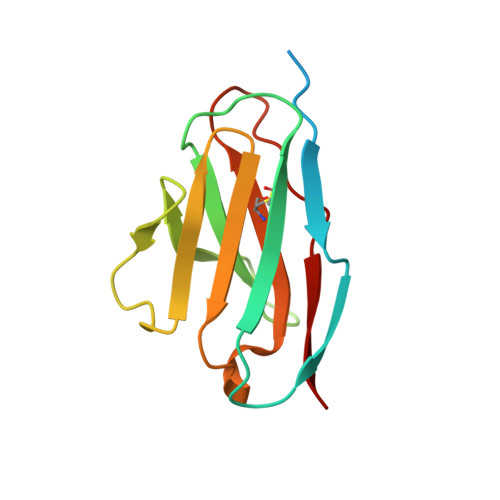Kinetic control in protein folding for light chain amyloidosis and the differential effects of somatic mutations.
Blancas-Mejia, L.M., Tischer, A., Thompson, J.R., Tai, J., Wang, L., Auton, M., Ramirez-Alvarado, M.(2014) J Mol Biol 426: 347-361
- PubMed: 24157440
- DOI: https://doi.org/10.1016/j.jmb.2013.10.016
- Primary Citation of Related Structures:
4K07 - PubMed Abstract:
Light chain amyloidosis is a devastating disease where immunoglobulin light chains form amyloid fibrils, resulting in organ dysfunction and death. Previous studies have shown a direct correlation between the protein thermodynamic stability and the propensity for amyloid formation for some proteins involved in light chain amyloidosis. Here we investigate the effect of somatic mutations on protein stability and in vitro fibril formation of single and double restorative mutants of the protein AL-103 compared to the wild-type germline control protein. A scan rate dependence and hysteresis in the thermal unfolding and refolding was observed for all proteins. This indicates that the unfolding/refolding reaction is kinetically determined with different kinetic constants for unfolding and refolding even though the process remains experimentally reversible. Our structural analysis of AL-103 and AL-103 delP95aIns suggests a kinetic coupling of the unfolding/refolding process with cis-trans prolyl isomerization. Our data reveal that the deletion of proline 95a (AL-103 delP95aIns), which removes the trans-cis di-proline motif present in the patient protein AL-103, results in a dramatic increment in the thermodynamic stability and a significant delay in fibril formation kinetics with respect to AL-103. Fibril formation is pH dependent; all proteins form fibrils at pH2; reactions become slower and more stochastic as the pH increases up to pH7. Based on these results, we propose that, in addition to thermodynamic stability, kinetic stability (possibly influenced by the presence of cis proline 95a) plays a major role in the AL-103 amyloid fibril formation process.
Organizational Affiliation:
Department of Biochemistry and Molecular Biology, Mayo Clinic, 200 First Street Southwest, Rochester, MN 55905, USA.















